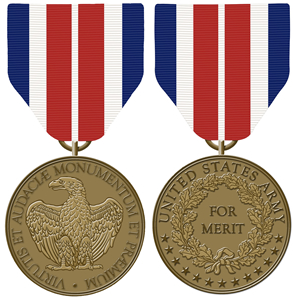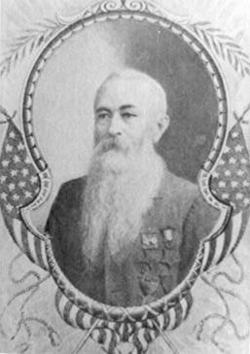Related Research Articles

Philip Kearny Jr. was a United States Army officer, notable for his leadership in the Mexican–American War and American Civil War. He was killed in action in the 1862 Battle of Chantilly.

The Order of the Red Banner was the first Soviet military decoration. The Order was established on 16 September 1918, during the Russian Civil War by decree of the All-Russian Central Executive Committee. It was the highest award of Soviet Russia, subsequently the Soviet Union, until the Order of Lenin was established in 1930. Recipients were recognised for extraordinary heroism, dedication, and courage demonstrated on the battlefield. The Order was awarded to individuals as well as to military units, cities, ships, political and social organizations, and state enterprises. In later years, it was also awarded on the twentieth and again on the thirtieth anniversary of military, police, or state security service without requiring participation in combat.

The United States Armed Forces awards and decorations are primarily the medals, service ribbons, and specific badges which recognize military service and personal accomplishments while a member of the U.S. Armed Forces. Such awards are a means to outwardly display the highlights of a service member's career.

The Certificate of Merit Medal was a military decoration of the United States Army that was issued between the years of 1905 and 1918. The Certificate of Merit Medal replaced the much older Certificate of Merit which was authorized by the United States Congress on March 3, 1847.
Awards and decorations of the United States Army are those military awards including decorations which are issued to members of the United States Army under the authority of the Secretary of the Army. Together with military badges such awards provide an outward display of a service member's accomplishments.

Richard Conner was an American Civil War Union Army soldier who received the Medal of Honor for his bravery in action.

Forrester Lore Taylor was an officer in the Union Army during the American Civil War who received the Medal of Honor for his bravery at the May 3, 1863 Battle of Salem Church.

The War Order of Virtuti Militari is Poland's highest military decoration for heroism and courage in the face of the enemy at war. It was created in 1792 by Polish King Stanislaus II Augustus and is the oldest military decoration in the world still in use.

Vivandière or cantinière is a French name for women who are attached to military regiments as sutlers or canteen keepers. Their actual historic functions of selling wine to the troops and working in canteens led to the adoption of the name 'cantinière' which came to supplant the original 'vivandière' starting in 1793. The use of both terms was common in French until the mid-19th century, and 'vivandière' remained the term of choice in non-French-speaking countries such as the US, Spain, Italy, and Great Britain. Vivandières served in the French army up until the beginning of World War I, but the custom spread to many other armies. Vivandières also served on both sides in the American Civil War, and in the armies of Spain, Italy, the German states, Switzerland, and various armies in South America, though little is known about the details in most of those cases as historians have not done extensive research on them.

Lorinda Anna "Annie" Blair Etheridge was a Union nurse and vivandière who served during the American Civil War. She was one of only two women to receive the Kearny Cross. She was inducted into the Michigan Women's Hall of Fame in 2010.
John B. Frisbee was a Union Navy sailor in the American Civil War and a recipient of the U.S. military's highest decoration, the Medal of Honor, for his actions at the Battle of Forts Jackson and St. Philip.

The Medal of Honor (MOH) is the United States Armed Forces' highest military decoration and is awarded to recognize American soldiers, sailors, marines, airmen, guardians and coast guardsmen who have distinguished themselves by acts of valor. The medal is normally awarded by the president of the United States, the commander-in-chief of the armed forces, and is presented "in the name of the United States Congress," it is sometimes referred to as the "Congressional Medal of Honor". The Secretary of the Army, on behalf of DoD, has testified to Congress that the term "Congressional Medal of Honor" is "incorrect" as a matter of statute, and that "it seems inappropriate to modify the name of the medal with the word 'Congressional' as each award is made in the name of the Congress," through a mandated process in the military chain of command, not 'by' Congress, and there is no other Medal of Honor, so no need for the modifier.

William Bliss Hincks was a Union Army soldier in the American Civil War who received the U.S. military's highest decoration, the Medal of Honor.

Lorenzo Dow Immell was a Union Army soldier in the American Civil War who received the U.S. military's highest decoration, the Medal of Honor.
Charlotte Elizabeth McKay was an American editor, Union Army nurse, and an anti-suffragist. She worked as a field nurse during the American Civil War, receiving a Kearny Cross from the 17th Maine Volunteer Infantry Regiment, whom she had cared for after the Battle of Chancellorsville. She was the first woman who protested against the suffrage movement, and she was the editor of the first American anti-suffrage periodical, The True Woman.

Marie Brose Tepe Leonard, known as "French Mary," was a vivandière of Franco-Turkish descent who fought for the Union army during the American Civil War. Tepe served with the 27th and 114th Pennsylvania Infantry Regiments.

Alexander H. Mitchell was a United States military officer who fought with the Union Army during the American Civil War as captain of Company A of the 105th Pennsylvania Infantry. Wounded multiple times in combat during the war, he was awarded the Kearny Cross for his distinguished service in the Battle of Chancellorsville, Virginia in May 1863, and was then also awarded his nation’s highest award for valor, the U.S. Medal of Honor for his capture of a Confederate flag in hand-to-hand combat with the color-bearer of the 18th North Carolina Infantry during the Battle of Spotsylvania Court House on May 12, 1864.

Harvey May Munsell was an American soldier who fought with the Union Army in the American Civil War. Munsell received his country's highest award for bravery during combat, the Medal of Honor, for actions taken over the course of 13 engagements from July 1–3, 1863 during the Battle of Gettysburg.

Oscar Slagle was a private in the United States Army who was awarded the Medal of Honor for gallantry at the Battle of Elk River in Tennessee during the American Civil War.

Henry C. Slusher was a private in the United States Army who was awarded the Medal of Honor for actions performed on 11 September 1863 at Moorefield, West Virginia.
References
- ↑ Brockett & Vaughan 1867, pp. 515–516.
Bibliography
- Brockett, Linus Pierpont; Vaughan, Mary C. (1867). Woman's Work in the Civil War: A Record of Heroism, Patriotism and Patience. Zeigler, McCurdy & Company. p. 514.